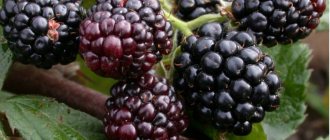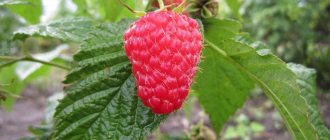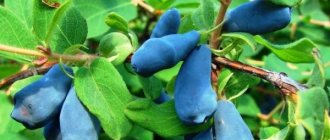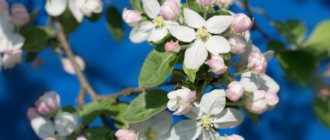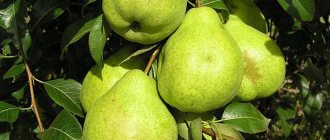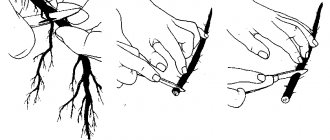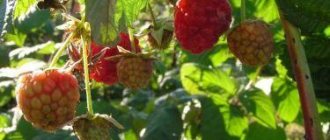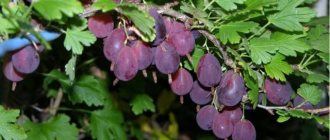The article presents Polar blackberries: description of the variety, photos, instructions for growing, care, and propagation.
Blackberries have been deprived of the attention they deserve for many years. The varieties grown by gardeners in their gardens very often had a bad taste, their branches and leaves were strewn with thorns, and they did not have time to reach full ripening before frosts began, even if they grew in the central part of Russia. This is the reason for the joy and excitement around every new product that appears on our markets. European varieties are especially attractive due to the fact that the climatic conditions there are similar to ours rather than to North American ones. One of these varieties is the blackberry variety Polar, created by Polish scientists.
Blackberry Polar: history of origin of the variety
Blackberry Polar: photo
The Polar blackberry bush was created thanks to scientists at the Institute of Horticulture in the city of Brzezn in Poland. It was registered in the year 8 of the 21st century. Breeders set themselves the task of breeding blackberries that would not need shelter during the winter cold.
Polar blackberries were created for cultivation on an industrial scale, but due to the high quality of the berries and low maintenance requirements, they began to be actively grown in private gardens.
Blackberry Polar: description and characteristics of the variety
Blackberry Polar: photo
Blackberry Polar is a subshrub with powerful upright shoots 2.7 meters long. Unpruned tops on the vines can sometimes look drooping, but this is nothing to worry about because this is part of the variety. The shoots of this variety are completely free of thorns. When young, the color of the lashes is bright green, and by the end of the season they become light brown. The shoots of the first year of life, on which the fruits are formed, are brown, the cross-section is in the shape of a flattened circle. The branches are strewn with rich green, large, five-segmented or three-segmented leaves. The roots of the Polar blackberry variety are powerful. There is practically no growth. Blooming with large white flowers begins in the first days of May. The fruits are large in size with dense skin, mostly uniform. Their weight is from 9 to 11 grams. Those that appear first are usually the largest in size. The berries have a beautiful oval shape and a glossy black sheen.
The sweet taste of Polar blackberries is diluted with a slight sourness, has no bitter aftertaste and the fruit emits a pleasant aroma. This berry earned a high tasting score of 4.5 points, which completely coincided with the reviews of amateurs.
Blackberry variety Polar: photo
The characteristics of the Polar blackberry make it possible to grow it not only in the southern part of the country, but also in the north. Considering that this variety is very unpretentious and the quality of the fruit is high, it turns out that it is almost ideal for cultivation in private gardens or for industrial production on large plantations.
The creators of the Polar blackberry gave a description that completely coincides with the reviews of those who have already planted it on their plots. Probably the reason for this was the fact that the breeding took place in a state bordering us and the variety was created for industrial production. This suggests that the easy care required when growing on large plantations was implied.
Blackberries Polar are highly resistant to drought. However, it is important to remember that blackberries are a moisture-loving plant and in order to get good yields, the bushes need to be watered periodically.
Since the main task for Polish breeders was to create a variety that did not need to be covered, the result was the most frost-resistant blackberry bushes. Plants require shelter only if they are grown in regions where the thermometer stays below -23 degrees for a long time. It should be noted that experts talk about the plant’s ability to tolerate 30-3 degree frosts for a short time.
Blackberries growing in the Moscow region must be covered.
However, gardeners who grow them say that by covering powerful shoots, which is not so easy to do, the yield will increase three or even 5 times. The reason is that the flower buds freeze, while nothing happens to the shoots. So there is something to think about.
The Polar blackberry variety has no special requirements for soil type and tolerates transportation well.
Features of cultivation
The variety is undemanding to growing conditions and takes root in any soil, but to get a good harvest you need to follow a number of important recommendations:
- In order for the plant to take root well, planting is carried out from March to mid-April. If you received a seedling in September or October, feel free to plant it, but for the winter the blackberry needs to be well covered.
- Select a windless, sunny site; blackberries do not like excess moisture; the plant is more comfortable on well-drained loams.
- The holes are prepared so that the root of the seedling fits completely; the root collar should be at ground level. Drainage material is placed at the bottom of the pit, and a mixture of 5 kg of compost, 35 grams of superphosphate, 15 grams of potassium salt, a handful of wood ash and garden soil is prepared for backfilling.
- For the winter, even if mild winters prevail in the region, it is better to cover Polar blackberries. If this procedure is neglected, the yield decreases noticeably. It is necessary to prepare the plant for shelter as early as possible, preferably immediately after the end of the fruiting period. At this time, the stems are still flexible; closer to winter they become woody;
- Blackberries need watering during drought and fertilizing throughout the season. The bushes need to be moistened moderately, avoiding waterlogging of the soil. The first fertilizing session is carried out in early spring, the second during flowering, and the last when all the berries are ripe.
The Polar blackberry begins to bear fruit in the second year after planting, and after another 2 years it can begin to be propagated. The upper parts of shoots and root shoots are suitable for this.
Trimming
The procedure should be carried out twice a season. In the spring, all frozen parts of the bush are removed, and in the fall, you can carry out shaping pruning at your discretion. In general, some gardeners do not prune the bush, but tie long stems to strong trellises as they grow; in the fall they are tied off and covered for the winter.
Selection of seedlings
The birthplace of the Polar blackberry is Poland, so it is very difficult to find pure-quality seedlings here. And if we also take into account the enviable characteristics of this berry, the number of people willing to sell the most common variety, attributing to it the proud name “Polar,” doubles.
To avoid being deceived, when purchasing, ask the seller to present all the necessary documents and certificates. It’s even better to buy such plants at exhibitions; they are often held at botanical gardens and agricultural fairs. Be careful, there are no thorns on the Polar blackberry shoots.
Also, when choosing planting material, you should carefully examine the plant. Seedlings are sold with both open and closed root systems. The stems should not show any damage or signs of disease, and the roots should be strong and developed. Buy only the best copies.
Blackberry Polar: flowering and yield of the variety
Flowering occurs at the beginning or mid-May, it all depends on the region in which the plant is grown and what the weather conditions are. Polar is a mid-early variety; the first batch of its fruits ripen in July, approximately in the second week.
Full harvests will be collected after three years of life in the garden. You can harvest delicious berries starting in July and ending in the last days of September.
It should be noted that in the middle latitudes, harvesting begins in the last days of July or in August. In Poland, an average of 4 kg is harvested from one three-year-old bush. berries If you provide the plant with shelter during the winter cold, the yields will be significantly higher. When flower buds freeze, the yield drops.
What is the reason for such great popularity of Polar blackberries? The reason is the ability to plant more densely and harvest crops using a mechanized method. There is no need to spend effort, time and money on creating shelters for the winter. For these reasons, this berry becomes not only tasty and healthy, but also profitable to grow from an economic point of view. In garden plots, planting can be free, it can be easily covered and, as a result, high yields can be obtained.
Farmer reviews
Nikolai Mitrofanovich, Moscow region
I have been growing Polar blackberries at my dacha for six years now. This is a vigorous plant that requires regular pruning. Fruits generously, the berries have excellent taste and good presentation. During the season, it is possible to make a profit from the sale of fresh fruits and the sale of excellent jam. I recommend it to novice gardeners, since the crop is not demanding on agricultural technology.
Evgeniy, Rostov region
The Polar variety is new to me, but after three years of cultivation they can note the plant’s high resistance to diseases, parasites and adverse weather conditions. He set up a blackberry plantation on 50 acres. The production is profitable, in addition to selling fresh berries, it turns out to use part of the harvest to make jam and preserves. Even leaves are used. After thorough washing and drying, they produce wonderful, and most importantly, healthy tea. I plan to expand production by renting a larger area for blackberries.
Valentina, Tver region
I, as a novice farmer, decided to consult with experienced farmers about choosing a blackberry variety for cultivation on a large scale. Of the 4 varieties offered, there was Polar. I have never regretted my decision. The first year was not so optimistic due to frosts in May, when the blackberries began to bloom. And the second year opened up prospects made possible by the fertility of the Polar blackberry and the ideal combination of flavor notes. I remove 3.5-4 kg from a bush.
Watch the video about Polar blackberries:
Blackberry Polar: advantages and disadvantages of the variety
Polar blackberries have excellent taste, high lightness, long shelf life and the ability to be transported over long distances. All this makes it possible to sell fresh berries in any corner of the country. In addition, they lend themselves well to freezing and are suitable for making juices, wines and various preparations. Resistance to diseases and harmful insects:
The immunity that this variety possesses protects the plant from various diseases. However, preventive measures should not be canceled. It is especially important to carry them out during industrial cultivation, where, as a rule, the plantings are very dense.
We can safely talk about the pros and cons, since the plant has been tested in the country and they have been studied quite well, although a little more than 10 years have passed since its breeding. The variety has many more positive qualities
- The berries are very beautiful and large
- Highly rated for taste
- Excellent commercial quality and transportability
- No need for shelter
- The most winter-hardy
- Thornless variety
- Can be planted closely together
- Has proven itself worthy in industrial and private cultivation
- Resistance to diseases and harmful insects
- You can use mechanized equipment for harvesting
- The ability to increase productivity significantly by using shelter during the winter cold
- The leaders among varieties that are very easy to care for.
The disadvantages include:
- Requires shelter in mid-latitudes
- Due to powerful shoots, preparation for the winter period in the north of the country is difficult;
- Some flower buds freeze out when the temperature drops and there is no shelter;
- There is practically no root growth, which makes propagation in this way somewhat more difficult.
Reproduction and planting of Polar blackberries
Reproduction is quite simple using apical shoots. However, some effort will still have to be made, since it will be necessary to tilt the selected branch starting from a young age. There are practically no root shoots, and propagation using green cuttings is quite difficult due to their thickness and tendency to rot. To grow several new bushes, you need to put on a large number of shoots. You can propagate the plant by dividing an adult bush.
Landing dates
Caring for and planting Polar blackberries is so simple that even a novice gardener who has never done this before can easily cope with it. To avoid unnecessary labor costs, you only need to follow a few rules.
Planting in the south of the country is carried out in the autumn after the hot days have ended. The bushes will have enough time to adapt and take root before frost sets in. When spring comes, they immediately begin to grow.
Planting in the Moscow region and mid-latitudes is carried out in the spring, after the soil has warmed up and the threat of return frosts has disappeared.
Landing location
To grow on an industrial scale, you need to choose a flat area so that equipment can pass without difficulty. On a personal plot, you should choose a place that is well lit by sunlight and protected from strong winds. The location of groundwater should be at least one and a half meters below the surface of the earth. The best soil is nutrient-rich loam with a low acidity level.
Soil preparation
A couple of weeks before planting, you need to dig planting holes 50 centimeters deep and the same diameter. The hole is filled 2/3 with earthen mixture and filled with water. To prepare the earth mixture, you need to mix the top fertile layer of soil with humus (1 bucket), potassium (50 grams) and phosphorus (150 grams). If the soil is highly acidic, it should be diluted with lime. If it is too dense, then sand should be added there. If alkaline or neutral, then acidic peat should be used.
How to select and prepare Polar blackberry seedlings for planting
The purchase of Polar blackberry seedlings should be made in specialized stores to avoid fraud. Please note that the roots are developed, there is no damage and smell fresh, the shoots must be green.
If the plant was purchased with an open root system, then they must be soaked 12 hours before planting.
How to plant
To grow Polar blackberries on an industrial scale, planting can be done at a distance of 90 centimeters; if it is possible to feed intensively, then the distance can be reduced to 80 centimeters. In a private garden, planting is best done at a distance of one and a half, or even two meters, this will have a very good effect on the taste of the fruit. The distance between rows should be maintained at 2.5 meters.
When planting, first of all you need to shorten the branches, leaving a length of 20 centimeters. A mound is made in the center of the hole on which a Polar blackberry seedling is placed and the roots are carefully straightened. Then you need to fill the hole with earthen mixture so that the root collar goes to a depth of 1.5 centimeters. Next, the earth is compacted, abundantly watered with 10 liters of water and mulching is carried out.
Landing rules
For full ripening, pronounced taste and aroma, a place for planting Polar blackberries must be chosen that is illuminated and warmed by the sun throughout the day, protected from cold draft winds. Considering that blackberries have deep roots, the lowland is not suitable for planting. The soil is suitable loamy or sandy loam with neutral acidity.
Clay soil is mixed with sand or peat, and soil that is too rocky and sandy is dug up with clay and humus. Acidic soil can be corrected by liming; you can scatter wood ash or cement over the area.
The place for blackberry plantation is prepared several weeks before planting the cuttings. The area is dug up, cleared of weeds, and fertilized with manure or humus. Holes for cuttings are dug measuring 40 x 40 x 40 cm at a distance of 1 - 1.2 m from each other. Sand with stones or broken bricks are poured at the bottom of the hole, expanded clay can be used, all this is necessary for soil drainage, especially if the site has heavy clay soil. A nutrient mixture is prepared in the wells. This can be rotted manure, rotted compost, wood ash, garden soil, you can add superphosphate and potassium salt. All this needs to be mixed with the soil from the hole so that the roots do not touch the fertilizer.
Read also: Centurion onion (sets): description and characteristics of the variety, planting and care
Polar blackberry cuttings are planted in holes in early spring or autumn at an air temperature of 10 - 12 degrees Celsius.
The contents of the hole are generously filled with water. When the water has been absorbed, the cutting is immersed in the hole and covered with fertile soil of the turf layer. The root collar should be no deeper than 1 – 1.5 cm. The tree trunk circle should be mulched with any dry plant material.
Considering that the shoots of the Polar blackberry are tall, immediately after planting, before the bush has grown, you need to install trellises with three-row wire tension for garter. Types of garter include fan and T-shaped. With a T-shaped trellis, gardeners tie young shoots on one side and fruit-bearing shoots on the other, making it easier to control and harvest.
When grown in the northern regions, a fan garter is practiced, when young shoots are bent and fixed at an angle of 45 degrees, then lowered even lower to the ground, and new shoots are tied in their place. It is important to start bending the shoots while they are flexible and thin. This method of garter helps cover the branches for the winter.
Blackberry Polar: description of care
Watering a young plant is carried out twice every 7 days. In the future, no difficulties will arise.
Blackberry Polar requires obligatory garter to trellises. They can be multi-row, T-shaped, fan-shaped. Last year's growths are tied to one side, new ones to the other. What the yields will be is influenced by how intensively fertilizing is carried out, whether the bush is covered for the winter, whether young shoots are pinched and whether watering measures are carried out during the drought period.
Watering is carried out if there is no rain, this is especially important during hot periods. It is important to remember that Polar blackberries love moisture and it is better to water them too much than to let the roots dry out.
Feeding is not necessary, but if it is completely absent, the yields will be significantly lower. It is better to fertilize and do this three times a season. The first feeding is carried out with the onset of spring using nitrogen fertilizers. Second, when flowering begins, a complex of minerals is used here. Third, after harvesting using potash fertilizers.
If you see yellowing of the leaves on your plant, but the veins on them remain green, then the plant has become ill with chlorosis. This disease occurs due to a lack of iron. In order to rid the plant of the disease, it is necessary to use chelates.
Loosening Polar blackberries is carried out twice, in early spring and autumn. In the middle of the growing season, it is necessary to mulch the soil using red peat. It will serve to acidify the soil, retain moisture, prevent weeds from developing and allow air to penetrate well to the roots of the plant.
Reproduction methods
The Polar variety can be propagated on a plot in several ways: by dividing the bush, cuttings, and apical layering. In the first case, the blackberries are dug up and divided into parts, each of which must have a shoot and a root system. Old cuttings are discarded, young ones are planted in the garden.
Propagation by cuttings is carried out in the fall. To do this, cut annual shoots 40 centimeters long and dig them halfway into the ground. In the spring they are dug up, trimmed a little on both sides, and buried again. Soon bushes with 2-3 true leaves will grow in the garden bed, after which they are dug up and planted first in pots for growing, then in a permanent place.
To grow Polar blackberries using apical cuttings, perform the following steps:
- The ends of annual shoots are bent to the ground and pinned. A 15-20 centimeter long top is left on the surface. The place where the shoot comes into contact with the ground is cleared of leaves.
- The cuttings are watered and hilled. In a month the first roots and leaves will appear.
- In spring, young plants are separated from the mother bush and planted in a permanent place.
Reproduction by layering is carried out at the end of summer. At this time, both the one-year-old shoot is ripe and the layering during the procedure has time to take root by winter.
Pruning rules
As soon as the entire harvest is harvested, you need to start pruning the shoots. There should be no delay; there must be enough time for the wood on the new lashes to mature before the frosts begin.
After pruning, there should be from 4 to 7 lashes left, the number depends on what scheme was used for planting. In order for the side shoots to branch better, they must be pinched as soon as they grow 45 centimeters in length. All branches with signs of damage, weakening and improperly growing are cut off to the base.
Recommendations for growing the variety
Experts advise carrying out planting work in March - April.
It is better to purchase seedlings from a local fruit nursery.
During the spring and summer, the root system of the seedlings has time to adapt and the blackberries will not freeze in winter. If planting was not carried out in the spring, the work is postponed to September - October. But in this case, it will be necessary to trim the shoots to 30 cm and cover the young seedlings.
- For planting blackberries, choose loamy soils with good drainage . Waterlogged lowlands are not suitable for growing blackberries. The landing site should be sunny. Berries ripen faster in well-lit beds. In the shade, the harvest may not wait.
- Planting is carried out according to the following scheme: 0.8-0.9 m , and 2 m . The greater the distance between plants, the higher the yield from each bush.
Preparing Polar blackberries for winter
There is no need to cover the plant in the southern regions, but in the rest of the territory it should be done. Where the thermometer drops below -15 degrees extremely rarely, it will be enough to hill up the roots and, without removing the lashes from the trellis, cover them using agrofibre. The main thing is to prevent the covering material from icing.
As for regions with frostier winters, more efforts will need to be made there. Having removed the shoots from the trellises, they must be lowered to the ground and secured. Next, cover the plant with spruce branches, straw or agrofibre.
